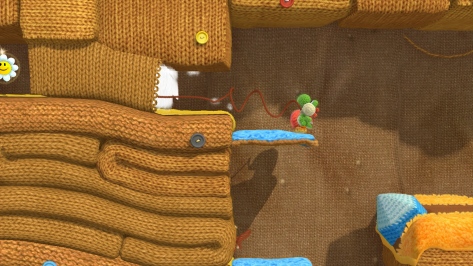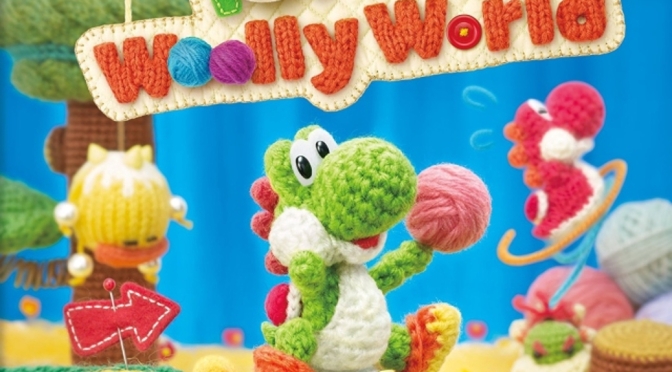
When a friend and I beat Kirby’s Epic Yarn about a month ago, the decision on what we’d play next was pretty easy. Kirby’s Epic Yarn was a relatively simple side-scrolling platformer with enjoyable co-operative gameplay, some inventive stages, and an incredible design aesthetic. It was a game that just emanated happiness. Yeah, we wanted more of that. And so, we tracked down a copy of Yoshi’s Woolly World, the spiritual successor to Kirby’s Epic Yarn. Structurally, the two games weren’t awfully different, and mechanically, the stars in both functioned similarly. But the abilities unique to Yoshi, namely tossing eggs, allowed for a broader range of platforming challenges and additional ways to interact within stages; it was slightly tougher, and more engaging. These considerations, in partnership with the remarkable art design, resonated with me; Yoshi’s Woolly World was an outstanding video game!
Unlike Kirby’s Epic Yarn, which was adapted into a Kirby game well into development, Nintendo intentionally sought out Good-Feel to develop a new entry in the Yoshi series. Since Good-Feel’s founding in 2005, by former members of Konami Computer Entertainment Kobe, they have enjoyed a strong relationship with Nintendo, working on full-scale releases like Wario Land: Shake It! and smaller projects, such as games for the 3DS StreetPass app. In light of the studio’s penchant for platformers, and the renown Yoshi games generally receive for their visual identity, there may not have been a better studio to develop Yoshi’s Woolly World.

It debuted on the Wii U in Europe and Australia in June 2015, before releasing in Japan and North America in July and October of the same year. An expanded version was also published on the 3DS in early 2017, retitled Poochy & Yoshi’s Woolly World. This release appears to have some neat additions, and while I’m not personally familiar with it, it sounds like the Wii U version is still the premier rendition. Although it originated on the Wii U, there really wasn’t any consideration paid to the GamePad. I could’ve played the game in its entirety on the GamePad’s screen, but even if I wasn’t playing cooperatively, I think I’d still want to see the beautiful graphics blown up on the television. Since the game adhered to a side-scrolling format, and utilized none of the platform’s unique traits, almost any Wii U compatible controller could be used, including the Super Nintendo controllers that came with the SNES Classic. Very neat!
Reprising their roles as the go-to trouble makers for the series, Kamek and Baby Bowser were once again up to no good. This time around, the feisty Magikoopa swooped in on a group of Yarn Yoshis and callously reduced the majority of them into bundles of yarn. A pair escaped this fate and gave chase to Kamek. As they ventured across the knitted island, dropped bundles of yarn, five in each stage, could be collected to reassemble their friends. Of the various collectibles strewn about the stages, my friend and I paid special attention to hunting these down. Most were hidden or out of reach in such a way that our platforming acumen was tested above and beyond what simple stage completion required. Accordingly, obtaining them was fun in and of itself, although doing so also unlocked new Yoshis to play as. There was no functional difference from one Yoshi to another, but the variety of knitted patterns was cool.

On the topic of functional differences, this was the first Yoshi game I’ve played and he’s pretty similar to Kirby, huh? For instance, after jumping, both characters have the ability to hang in the air for an extended period of time. In Kirby’s case, successive pressings of the jump button caused him to inhale and get a little extra oomph, and ultimately hover to slowly descend. Holding the jump button after Yoshi leapt off the ground triggered his flutter jump, where he rapidly kicks to stay in the air another second or two, even gaining a bit of altitude in the process, thanks to a brief second wind. Another similarity, they have a propensity to eat anything around them, including enemies. Both can spit their foes out and use them as a projectile, or digest them, with differing results. Kirby famously copies the abilities of certain foes while Yoshi turns his swallowed foes into eggs, ammunition to be thrown.
With at least one egg in tow, or yarn ball in this game’s case, we were ready to blast enemies, switches, and make platforms where able. An automatic aiming cursor popped up when one of us wanted to throw a yarn ball; it didn’t automatically target objects or foes though, the cursor moved up and down on its own. Until we got accustomed to this, it was easy for aiming to slow us down. We were pretty methodical about searching stages for collectibles, and wanting to be accurate, we’d sometimes allow our cursor to cycle once or twice before actually throwing. Over time, we did get used to throwing eggs, and picked up tricks, such as holding a direction and immediately throwing, instead of waiting for the cursor to appear and do its thing. Realizing how prevalent eggs were was also beneficial; there was no need to hang on to them like consumables in an RPG.

Understandably, throwing eggs was crucial to a lot of stage design. Sometimes we caused platforms to materialize out of thin air, sometimes we cut through spongy material, and all the time we were chunking eggs at our enemies to clear a safe path. In many of my favorite stages however, egg throwing wasn’t critical. In most cases, these stages were designed around a single inventive gimmick. There were two back-to-back stages in World 4 that cemented themselves in my mind before my friend and I had even finished them. In Sunset at Curtain Falls, we clung to fast-moving drapes, and jumped from one to another before their curtain rods ended. It was a rollercoaster-like stage that wasn’t especially difficult… when we both reacted quickly, that is! It was followed by Spooky Scraps! Don’t’ Get Spooked! Transparent sheets cycled back and forth on this stage, revealing items and platforms that were otherwise invisible. We could stand on a platform up until the sheet passed, at which point the platform would disappear and our avatar would plummet.
There were also a handful of standout stages that placed our Yoshis in two-sided puzzle boxes. We’d start at the bottom and platform and puzzle our way up as far as we could, and then do the same on the other side. But beyond the design of the stages themselves, the clever stage design extended to placement of collectibles. As mentioned earlier, these were frequently located in off-the-beaten path spots that challenged us. The five bundles of yarn per stage were accompanied by five flowers, twenty Miiverse Stamps, and invisible clouds that appeared when we neared, commonly gifting beads or health; collectibles were plentiful, but not overwhelmingly so. Hard-earned beads could be spent to equip our Yoshis with badges that revealed hidden items or prevented death, among other single-stage benefits. We scoffed at their expensive cost early on, but grew fond of complementary pairings; we learned to spend beads, to make beads.

Working together, we were able to efficiently clear stages, sometimes with great ease. Like in Kirby’s Epic Yarn, we could “sacrifice” ourselves, forcing our character into a protective egg that floated towards the other player. If one of us was taking lead, or wasn’t going to make it, this was a great preventive method of avoiding additional trouble. Unlike that game however, we could die. If one player survived it was no big deal; the other would spawn in one of those floating eggs after a few seconds. But, if we both died, it was back to the latest checkpoint. This didn’t occur frequently enough to grow frustrating, but the liberal ways to grief each other caused it to be fairly common. Besides enemies and objects, our Yoshi avatars could also eat each other. There were moments when doing so, and launching the other a great distance, was beneficial. More often than not though, it was just fun to cause a little havoc.
As he did with Kirby’s Epic Yarn, Tomoya Tomita served as the lead composer for this game’s soundtrack. Joined by fellow Good-Feel composer Misaki Asada and Nintendo’s Kazumi Totaka, the tunes were more varied in this outing. I wouldn’t be able to point out a classic Yoshi song (if there is such a thing) due to my lack of familiarity with the series, so I’m going to assume there’s a mix of classic and new compositions. Both my friend and I agreed that the background music for the Lava Scarves and Red-Hot Blarggs stage left the greatest impression on us. It was a hard rock song with a groovy riff that wouldn’t have sounded out of place in Trigun. A few tracks, like the background music for A-Mazing Post Pounding implemented a funked out keyboard, while others were more thematically evocative of their setting, like a desert or winter wonderland. And still, there were plenty that could serve as the perfect accompaniment to a peaceful, springtime afternoon.

Yoshi’s Woolly World, like Kirby’s Epic Yarn, was a light-hearted good time. In both games, the visual identity was astounding, and unlike much else. It was a joy to venture through each stage and see how Good-Feel adapted knitted design into a side-scrolling platformer. And with a score as wonderful and varied as the game’s visual design, I couldn’t wait to hear what was next, as well. Beyond aesthetics, the actual stage design was delightful, especially when playing with a partner. The inventive, memorable gimmicks were a highlight, and the mechanics of hopping, bopping, and fluttering as Yoshi were novel to me. Aside from a few cases of slowdown in the later stages, this playthrough was an untarnished revelation; it’s one of the best platformers I’ve played.

2 thoughts on “Yoshi’s Woolly World [Wii U] – Review”